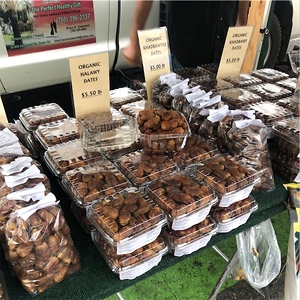


Halawi Dates
Estimated Inventory, lb : 0
This item was last sold on : 02/17/25
Description/Taste
Halawi dates are a medium-sized variety with an elongated oval-cylindrical shape. They have thin, caramel-colored skin with hints of burgundy hues. This skin is wrinkly and slightly sticky, seemingly almost too big for the flesh inside. The flesh feels firm but is easily pressed or bitten into. Its texture is fibrous, sticky, and chewy. The outer flesh closest to the skin is thick with a bright amber hue. When sliced in half, the innermost flesh appears to have white fibers that surround the fruit’s pit. The light brown pit resembles a pecan but is much harder and inedible. Halawi dates are quick to melt when eaten, becoming softer with each chew. They have a sweet buttery, caramel taste with notes of honey, similar to the flavor of pecan pie.
Seasons/Availability
Halawi dates ripen in the summer and have a peak season into fall. Since they are easily stored, this variety is available year-round.
Current Facts
Halawi dates are botanically classified as Phoenix dactylifera and belong to the Arecaceae family. This family also includes coconuts, acai berries, heart of palm, and dorum fruit. The name Halawi, sometimes spelled Halawy, means sweet in Arabic, the language of the fruit's native Iraq. This semi-dry variety has a similar appearance to Deglet Noor, a more commonly available type of date. Other popular cultivars include Medjool, Barhi, and Khadrawi dates. There are more than 200 varieties of dates that are eaten at various stages of ripeness. Khalal is the initial stage when dates begin to ripen, rutab is the stage when they become moister and sweeter, and tamar is the final stage when the dates are at their softest, driest, and have the deepest caramel flavor. Halawi dates can be enjoyed at any of these stages, but they are most often consumed raw or in baked goods in their tamar state.
Nutritional Value
Halawi dates are notably high in B vitamins, including B6, which support brain function, energy production, and mood regulation. They also provide dietary fiber, which aids digestion, helps manage blood sugar levels, and promotes satiety. This variety is a valuable source of copper and iron, both of which are crucial for red blood cell formation, immune system support, and energy metabolism. Halawi dates are rich in potassium and magnesium, minerals that help regulate fluid balance, maintain healthy blood pressure, and support muscle and nerve function. They are lower in sugar than other varieties, making them a good option for those with Type 2 diabetes. Their fiber content also helps to prevent sugar surges.
Applications
Halawi dates are most frequently used in their fresh and fully ripe form. They can also be an ingredient in baked goods like breads, cookies, cakes, and biscuits where their sweet flavor may serve as a natural substitute for sugar. Fresh Halawi dates are often chopped into salads, granola, yogurt parfaits, charcuterie boards, fruit cocktails, and acai bowls. They may be blended into smoothies or turned into syrups for pancakes, waffles, and cocktails. This variety can be mixed into stuffings or may be stuffed with goat cheese, nuts, and fresh herbs. Halawi dates are incorporated into a Moroccan dish called Chicken Tagine or used to make BBQ and caramel sauces. Halawi dates pair well with bananas, apricots, oranges, walnuts, pistachios, coconut flakes, cream cheese, feta cheese, cinnamon, ginger, turmeric, garlic, maple syrup, honey, brandy, rum, bacon, pork, poultry, olives, balsamic vinaigrette, and dark chocolate.
Ethnic/Cultural Info
Halawi dates can be incorporated into many Middle Eastern desserts. They’re frequently used to make cookies called maamoul that are consumed on holidays in the Middle Eastern region of Levantine. This confection, which is called kombe in Southern Turkey and kahk in Egypt, is a layered shortbread cookie that’s stuffed with date paste and covered in powdered sugar. It’s often eaten on Easter or during Eid-al-Fitr as a reward for fasting during Lent and Ramadan. Halawi dates may also be an ingredient in baklava, a dish likely developed in the Assyrian Empire of the Middle East and Eastern Europe. This dessert can involve layers of unleavened bread with chopped nuts, honey, and dates in between each layer.
Geography/History
Halawi dates are native to Iraq. They were first introduced into the United States in the early 1900s. By 1946, there were approximately 45 acres in California and 30 acres in Arizona designated to growing this variety. Halawi dates fare well in arid, desert-like climates and can tolerate humidity. They are commonly cultivated and exported from farms in Southern Iraq, where they are the second most common type of palm. Outside of Iraq, Halawi dates may be found at farmers' markets and grocery stores in the Middle East and Australia as well as California and Arizona, where large plots of farmland remain devoted to their production.
Recipe Ideas
Recipes that include Halawi Dates. One
| Curious Cuisiniere |
|
Stuffed Dates with Cream Cheese and Nuts |
Podcasts










